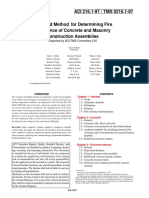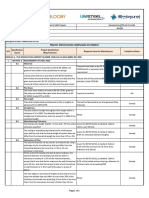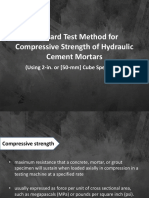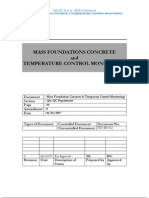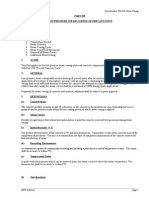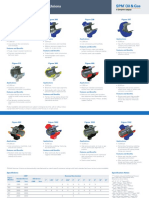Particular Specification For Reinforced Massive Concrete Structures
Uploaded by
karfungParticular Specification For Reinforced Massive Concrete Structures
Uploaded by
karfungParticular Specification for
Reinforced Massive Concrete Structures
1.
Definition
Reinforced Massive Concrete Structures include pile caps, transfer plates and structural
members where the least dimension exceeds 1.5 metres.
2.
Method Statement
At least two months before commencement of concreting, the Contractor shall submit a
method statement for temperature control. The information to be submitted shall include,
but not be limited to, the following:
3.
(a)
concrete mix details including heat of hydration and specific heat characteristics
of the cementitious constituents, expected concrete temperature rise and the
proposed initial concrete placing temperature;
(b)
formwork type and insulation;
(c)
curing details related to temperature effects;
(d)
maximum and minimum concrete placing temperatures;
(e)
minimum and maximum times before formwork is stripped;
(f)
any additional methods for controlling the concrete temperature;
(g)
concrete temperature monitoring proposals which shall be sufficient to
demonstrate that the requirements of the Contract will be met;
(h)
analyses and calculations to prove that the proposals will meet the requirements of
the Contract.
Concrete Trial Mixes
Trial mixes shall not be prepared until the SO has approved the Contractors mix design
in writing. Trial mixes shall be prepared under the supervision of the SO at least 35 days
before the commencement of concreting.
Structural Engineering Branch, Arch. SD
SE Instruction No. 05/2011
Issue Date : November 2011
Page 1 of 4
File code: sei0511.doc
CTW/MKL
Revision Date :
4.
Temperature Rise Evaluation Test
A Temperature Rise Evaluation Test (TRET) shall be made. The test shall consist of an
insulated 800mm800mm800mm concrete block constructed to the approval of the SO.
The block shall be instrumented with a minimum of three centrally located
thermocouples connected to an automatic data logger and hourly readings shall be taken
until the temperature has fallen to more than 10oC below the peak temperature. The
insulation of the concrete block shall be complete and equivalent to at least 200mm of
expanded polystyrene with additional protection provided as necessary. The concrete
block shall be constructed and instrumented to the approval of the SO. The information
gained during this test shall be used by the Contractor in the formulation of the
temperature control methods for the mix. The concrete blocks shall be retained for a
minimum of 3 months or as directed by the SO in a manner to ensure that damage or
degradation does not occur. The results of the TRET shall be used in conjunction with
the Contractors proposed insulation/cooling methods to evaluate compliance with the
temperature control requirements.
5.
Concrete Temperature Limits
Temperature control for concrete shall comply with the following requirements:
6.
(a)
The Contractor shall employ effective means such as shading the aggregates, precooling mixing water and adding flaked ice to ensure the temperature of concrete
prior to and including the time at which it is placed shall not exceed 25 oC.
(b)
After the concrete has been placed, its peak temperature in any part of the
structure shall not be permitted to rise above 85 oC.
(c)
After the concrete has been placed, the maximum temperature difference between
a point at the centre of a concrete section and the adjacent surface shall not be
greater than 20 oC times the shortest distance, in metres, between the concrete
section centre and the surface.
(d)
The Contractor shall employ effective means such as insulation, selection of
appropriate pour cycle times, or heating/cooling as necessary, to ensure that at any
time within 21 days after the concrete has been placed, the temperature
differential between any point in the freshly placed concrete of any structural
element at a distance of 600mm from a construction joint and the corresponding
point 600mm from the construction joint in the adjacent previously placed
structural element, shall not exceed 20 oC.
Concrete Temperature Measurement
Structural Engineering Branch, Arch. SD
SE Instruction No. 05/2011
Issue Date : November 2011
Page 2 of 4
File code: sei0511.doc
CTW/MKL
Revision Date :
(a)
The initial placing temperature of the concrete shall be measured by inserting a
calibrated probe-type thermometer, with a 1 oC accuracy, into each delivery of
the concrete at the time of discharge from the vehicle transporting it or not later
than 15 minutes thereafter. The thermometer shall be calibrated weekly.
(b)
The Contractor shall continuously compare the real time results of the on-going
temperature monitoring with the predicted values and make appropriate
adjustments to the temperature control methods used on current and subsequent
pours to ensure compliance with this Particular Specification.
(c)
The temperature of the hydrating concrete shall be measured for each pour until
21 days after pouring using a sufficient number of calibrated thermocouples to
demonstrate that the requirements of Clause 5 have been achieved, within a 2
o
C accuracy.
(d)
The thermocouples shall be suitably robust to withstand concrete placing, and be
adequately protected and firmly fixed in position on the reinforcement cage. The
thermocouples shall not be placed closer than 300mm to any cooling water pipes
to ensure that they give representative temperature readings.
(e)
The output of the thermocouples shall be continuously recorded using an
automated data logger. The power supply to the data logger shall be noninterruptible and the equipment shall be maintained and checked at least twice per
day to ensure that they are operating satisfactorily.
(f)
The thermocouples shall be calibrated in conjunction with the working and
backup data logger(s) and the calibration results shall be submitted at least 7 days
prior to incorporation within the Works.
(g)
After installation of the thermocouples within the pour and immediately prior to
concreting, the thermocouples shall be checked by comparing the relative ambient
temperature readings. Any damaged or malfunctioned thermocouple shall be
replaced prior to the commencement of concreting.
(h)
After the placing of concrete, the temperature readings shall be taken at a
maximum of hourly intervals for the initial 7 days after placing. The monitoring
frequency can be reduced to 12 1 hours thereafter until 21 days after placing or
until the maximum temperature is less than 15 oC above the daily minimum
ambient temperature.
(i)
The output from the data loggers shall be down loaded daily by the Contractor. A
copy of the data shall be given to the SO immediately after down loading in an
agreed electronic and hard copy format.
(j)
Within 7 days from the completion of the temperature monitoring period the
Contractor shall submit a report. The report shall include the individual tabulated
Structural Engineering Branch, Arch. SD
SE Instruction No. 05/2011
Issue Date : November 2011
Page 3 of 4
File code: sei0511.doc
CTW/MKL
Revision Date :
temperature results and calculated values indicating compliance, as required by
this Particular Specification, for all maximum and differential temperature
measurements. The report shall be presented in both tabulated and graphical
format and shall include all thermocouples within the same measurement plane on
the same graph to ensure that the temperature differentials between the core,
surface and ambient are readily discernable. Any non-compliance with this
Particular Specification shall be highlighted and proposals given for remedial
works and ensuring compliance in subsequent pours. If the non-compliance is on
the temperature limits as specified in Clause 5 above, the method statement shall
be reviewed and re-submitted to the SO for approval before further concreting of
reinforced massive concrete structure.
7.
Special Measures Involving More Than a Single Pour
If the Contractor proposes to concrete the reinforced massive concrete structure in more
than one operation, he shall demonstrate to the satisfaction of the SO that:
(a)
at all stages the temperature differential limits specified in Clause 5(c) will not be
exceeded at any one time;
(b)
the maximum temperature of 85 oC will not be exceeded;
(c)
the stresses in the concrete structure due to temperature changes under strain will
not induce tension cracks;
(d)
the construction joint will be treated to ensure monolithic action between the
different pours.
(e)
the temperature differentials between two adjacent pours will comply with Clause
5(d).
(f)
the temperature of concrete prior to and including the time at which it is placed
will comply with Clause 5(a).
Structural Engineering Branch, Arch. SD
SE Instruction No. 05/2011
Issue Date : November 2011
Page 4 of 4
File code: sei0511.doc
CTW/MKL
Revision Date :
You might also like
- Hot Weather Concreting (Ice Qty Calculation) - 1100% (1)Hot Weather Concreting (Ice Qty Calculation) - 12 pages
- Concrete Construction Article PDF - Using The New ACI 3010% (1)Concrete Construction Article PDF - Using The New ACI 3013 pages
- Self Consolidating Concrete Mix Design (Aci 237) : MaterialNo ratings yetSelf Consolidating Concrete Mix Design (Aci 237) : Material14 pages
- 4 Types of Cracks in Concrete Columns and Their CausesNo ratings yet4 Types of Cracks in Concrete Columns and Their Causes3 pages
- ACI-207.4R-93 Cooling and Insulating Systems For Mass Concrete100% (2)ACI-207.4R-93 Cooling and Insulating Systems For Mass Concrete22 pages
- TEC-032111C-SPD-CLT-Rev02 - Rebar-Core Wall Shop Drawing Checklist-80 (2020-04-17)No ratings yetTEC-032111C-SPD-CLT-Rev02 - Rebar-Core Wall Shop Drawing Checklist-80 (2020-04-17)2 pages
- Do'S & Don'Ts: "Quality Concrete, Reinforcement AND RCC in Major Projects"No ratings yetDo'S & Don'Ts: "Quality Concrete, Reinforcement AND RCC in Major Projects"43 pages
- 364.4T-10 Determining The Load Capacity of A Structure When As-Built Drawings Are Unavailable (TechNote)No ratings yet364.4T-10 Determining The Load Capacity of A Structure When As-Built Drawings Are Unavailable (TechNote)3 pages
- Mass Concrete Temperature Monitoring Example100% (1)Mass Concrete Temperature Monitoring Example12 pages
- Mastertop 528: Commercial Grade Self-Levelling Cementitious Floor UnderlaymentNo ratings yetMastertop 528: Commercial Grade Self-Levelling Cementitious Floor Underlayment3 pages
- Material Submittal For Concrete Wheel Stopper PDFNo ratings yetMaterial Submittal For Concrete Wheel Stopper PDF198 pages
- Concrete Durability Requirement Based On ACI-318-19No ratings yetConcrete Durability Requirement Based On ACI-318-1914 pages
- 2161 - 97 RC and Masonry Fire ResistanceNo ratings yet2161 - 97 RC and Masonry Fire Resistance26 pages
- Mass Concrete Thermal Cracking Probability JCI100% (1)Mass Concrete Thermal Cracking Probability JCI13 pages
- TEC-042226 - MET-DoR-002a (Method Statement For Rectification of The AAC Block Works)No ratings yetTEC-042226 - MET-DoR-002a (Method Statement For Rectification of The AAC Block Works)7 pages
- Project Specification Compliance StatementNo ratings yetProject Specification Compliance Statement2 pages
- ACI E702 8 22 Designing Concrete Structures Evaluation of ConcreteNo ratings yetACI E702 8 22 Designing Concrete Structures Evaluation of Concrete8 pages
- ForensicEngineeringMay262015 LoadTestingNo ratings yetForensicEngineeringMay262015 LoadTesting10 pages
- Acceptance of Concrete Cube Test ResultsNo ratings yetAcceptance of Concrete Cube Test Results3 pages
- California Bearing Ratio (CBR) Test PDFNo ratings yetCalifornia Bearing Ratio (CBR) Test PDF20 pages
- Particular Specification For Reinforced Massive Concrete StructuresNo ratings yetParticular Specification For Reinforced Massive Concrete Structures4 pages
- Mass Foundations Concrete and Temperature Control MoniteringNo ratings yetMass Foundations Concrete and Temperature Control Monitering20 pages
- Low Pressure Steam Curing of Precast UnitsNo ratings yetLow Pressure Steam Curing of Precast Units4 pages
- Procedure For REINFORCED MASS CONCRETE 01No ratings yetProcedure For REINFORCED MASS CONCRETE 014 pages
- CITY WALK (RESI 1 & 2) - Project Specific Details - REV 3 (17-12-2019)No ratings yetCITY WALK (RESI 1 & 2) - Project Specific Details - REV 3 (17-12-2019)4 pages
- Half-Day Seminar On "Advancement in Geotechnical Instrumentation and Monitoring"No ratings yetHalf-Day Seminar On "Advancement in Geotechnical Instrumentation and Monitoring"2 pages
- 01 Basantar Bridge Gad Well-Layout1.pdf1 PDFNo ratings yet01 Basantar Bridge Gad Well-Layout1.pdf1 PDF1 page
- Base Plate / Anchorage Design: ASDIP Steel 5.0.5No ratings yetBase Plate / Anchorage Design: ASDIP Steel 5.0.53 pages
- ITP-BWDF (Rev 0) - Brickwork & Door FramesNo ratings yetITP-BWDF (Rev 0) - Brickwork & Door Frames2 pages
- Karpaga Vinayakar Pipe Traders: H.O 56, Kakathope Street, Madurai - 625 001No ratings yetKarpaga Vinayakar Pipe Traders: H.O 56, Kakathope Street, Madurai - 625 0011 page
- Top Grades Tags: Home About Us Product E-Stock Selling List Contact UsNo ratings yetTop Grades Tags: Home About Us Product E-Stock Selling List Contact Us3 pages
- Specifications Excavation Termite ControlNo ratings yetSpecifications Excavation Termite Control30 pages
- Innovative Uses of Housing Lifting Techniques-JIARMNo ratings yetInnovative Uses of Housing Lifting Techniques-JIARM16 pages
- Technical Manual For Reparation of Washing Machine Proline FP6120WHNo ratings yetTechnical Manual For Reparation of Washing Machine Proline FP6120WH35 pages
- Concrete Construction Article PDF - Using The New ACI 301Concrete Construction Article PDF - Using The New ACI 301
- Self Consolidating Concrete Mix Design (Aci 237) : MaterialSelf Consolidating Concrete Mix Design (Aci 237) : Material
- 4 Types of Cracks in Concrete Columns and Their Causes4 Types of Cracks in Concrete Columns and Their Causes
- ACI-207.4R-93 Cooling and Insulating Systems For Mass ConcreteACI-207.4R-93 Cooling and Insulating Systems For Mass Concrete
- TEC-032111C-SPD-CLT-Rev02 - Rebar-Core Wall Shop Drawing Checklist-80 (2020-04-17)TEC-032111C-SPD-CLT-Rev02 - Rebar-Core Wall Shop Drawing Checklist-80 (2020-04-17)
- Do'S & Don'Ts: "Quality Concrete, Reinforcement AND RCC in Major Projects"Do'S & Don'Ts: "Quality Concrete, Reinforcement AND RCC in Major Projects"
- 364.4T-10 Determining The Load Capacity of A Structure When As-Built Drawings Are Unavailable (TechNote)364.4T-10 Determining The Load Capacity of A Structure When As-Built Drawings Are Unavailable (TechNote)
- Mastertop 528: Commercial Grade Self-Levelling Cementitious Floor UnderlaymentMastertop 528: Commercial Grade Self-Levelling Cementitious Floor Underlayment
- Concrete Durability Requirement Based On ACI-318-19Concrete Durability Requirement Based On ACI-318-19
- TEC-042226 - MET-DoR-002a (Method Statement For Rectification of The AAC Block Works)TEC-042226 - MET-DoR-002a (Method Statement For Rectification of The AAC Block Works)
- ACI E702 8 22 Designing Concrete Structures Evaluation of ConcreteACI E702 8 22 Designing Concrete Structures Evaluation of Concrete
- Particular Specification For Reinforced Massive Concrete StructuresParticular Specification For Reinforced Massive Concrete Structures
- Mass Foundations Concrete and Temperature Control MoniteringMass Foundations Concrete and Temperature Control Monitering
- CITY WALK (RESI 1 & 2) - Project Specific Details - REV 3 (17-12-2019)CITY WALK (RESI 1 & 2) - Project Specific Details - REV 3 (17-12-2019)
- Half-Day Seminar On "Advancement in Geotechnical Instrumentation and Monitoring"Half-Day Seminar On "Advancement in Geotechnical Instrumentation and Monitoring"
- Karpaga Vinayakar Pipe Traders: H.O 56, Kakathope Street, Madurai - 625 001Karpaga Vinayakar Pipe Traders: H.O 56, Kakathope Street, Madurai - 625 001
- Top Grades Tags: Home About Us Product E-Stock Selling List Contact UsTop Grades Tags: Home About Us Product E-Stock Selling List Contact Us
- Innovative Uses of Housing Lifting Techniques-JIARMInnovative Uses of Housing Lifting Techniques-JIARM
- Technical Manual For Reparation of Washing Machine Proline FP6120WHTechnical Manual For Reparation of Washing Machine Proline FP6120WH

































